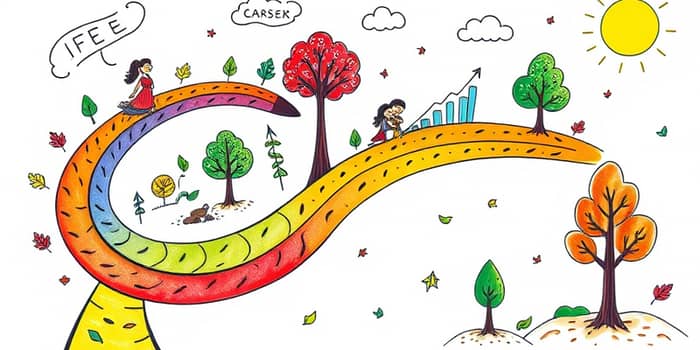
Life is a series of evolving stages, each calling for a distinct financial approach. By syncing your investment horizons with your personal journey, you can navigate change confidently.
Research shows most people face a major life transition every 12 to 18 months. Over a lifetime, we encounter three to five profound “lifequakes” that reshape our priorities and financial needs. Rather than reacting with stress, viewing these shifts as predictable phases empowers you to adapt your portfolio.
Emotional upheaval often accompanies transitions such as a new job, relocation, or loss. By anticipating these events, you can maintain stability through regular financial check-ins after each milestone. This proactive stance transforms uncertainty into opportunity.
In your 20s and early 30s, you’re building the groundwork. Key transitions include launching your career, moving out independently, and tackling student debt. Your investment focus should emphasize growth, accepting higher volatility for long-term gains.
Start with a solid budgeting routine and establish an emergency fund of three to six months of living expenses. Open retirement accounts like IRAs or a 401(k) and automate contributions. Aim to pay down high-interest debt swiftly, then redirect those payments into diversified equity holdings.
By prioritizing consistent savings and compounding returns, you set the stage for wealth accumulation. Even modest contributions now can swell over decades, easing future transitions.
During your mid-30s to 40s, life often centers on marriage, homeownership, and children. Expenses rise, but so does earning potential. Your portfolio should tilt toward growth while beginning to moderate risk.
Maximize employer-sponsored retirement plan contributions and explore catch-up options if you’re eligible. Open 529 plans for children’s education and consider life and disability insurance to protect your family. Regularly rebalance to maintain target asset allocations.
At this stage, save aggressively for key goals—a down payment, college funds, and retirement. Balancing these objectives ensures you remain on track, even as obligations increase.
Between your late 40s and mid-50s, you often hit peak income levels. With children approaching college and potential eldercare duties, flexibility is vital. Begin transitioning toward a more balanced portfolio.
Consider consolidating retirement accounts for streamlined management and pursue advanced tax planning strategies. Maintain growth exposure but increase allocations to bonds or dividend-paying assets. This asset allocation shift toward balanced portfolios reduces sequence-of-returns risk as you near retirement.
Continue maxing out tax-advantaged accounts, and consult a financial planner to refine your withdrawal strategy and estate plan.
In your mid-50s to early 60s, children may leave home and your focus turns to safeguarding gains. It’s time to emphasize capital preservation while preparing for a smooth transition to retirement.
Reduce equity exposure gradually and model your retirement income needs. Take advantage of catch-up contributions starting at age 50 to bolster your nest egg. Factor in healthcare costs and potential long-term care insurance.
This phase is critical for stress-testing your plan: What if markets falter? How will taxes impact distributions? By planning now, you mitigate unforeseen challenges and set realistic expectations.
After age 60, you shift from accumulation to distribution. Begin systematic withdrawals aligned with a sustainable rate—often guided by the 4% rule. Required Minimum Distributions (RMDs) start at age 73, so coordinate tax-efficient withdrawal strategies.
Focus on generating reliable income through annuities, bonds, and dividend-paying stocks. Maintain a modest equity allocation to combat inflation. Estate planning becomes paramount: update wills, trusts, and beneficiaries to ensure your legacy reflects your wishes.
By emphasizing monitor withdrawal rate guideline and prudent tax management, you transform your portfolio into a lasting resource for yourself and loved ones.
Integrate these habits to ensure your plan evolves with your life stages:
The following table maps common life stages to investment focuses and actionable strategies. It serves as a quick reference to align your portfolio with each major transition.
Life’s transitions are inevitable, but financial stress doesn’t have to be. By mapping your investment timelines to personal milestones, you create a dynamic plan that grows and adapts alongside you. Embrace change with proactive planning transforms uncertainty into opportunity and build lasting confidence in every stage of your journey.
References













